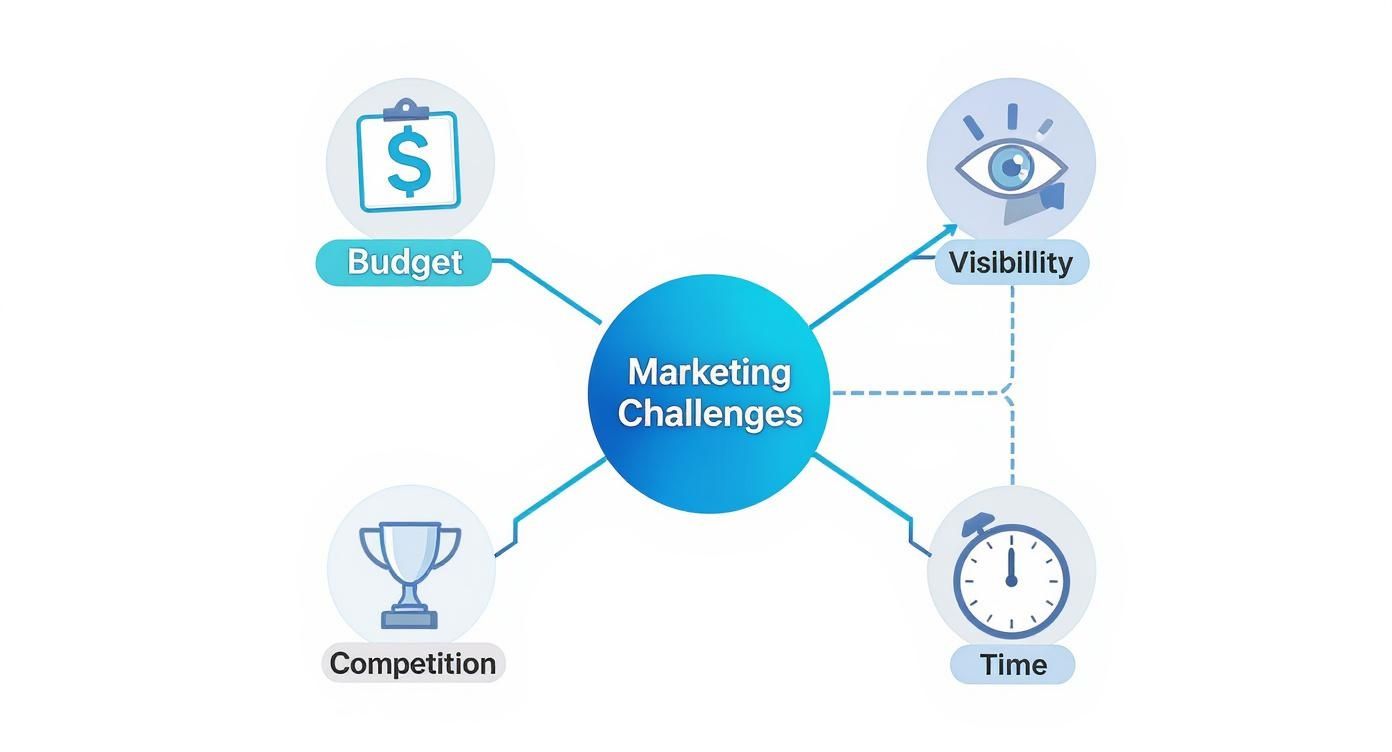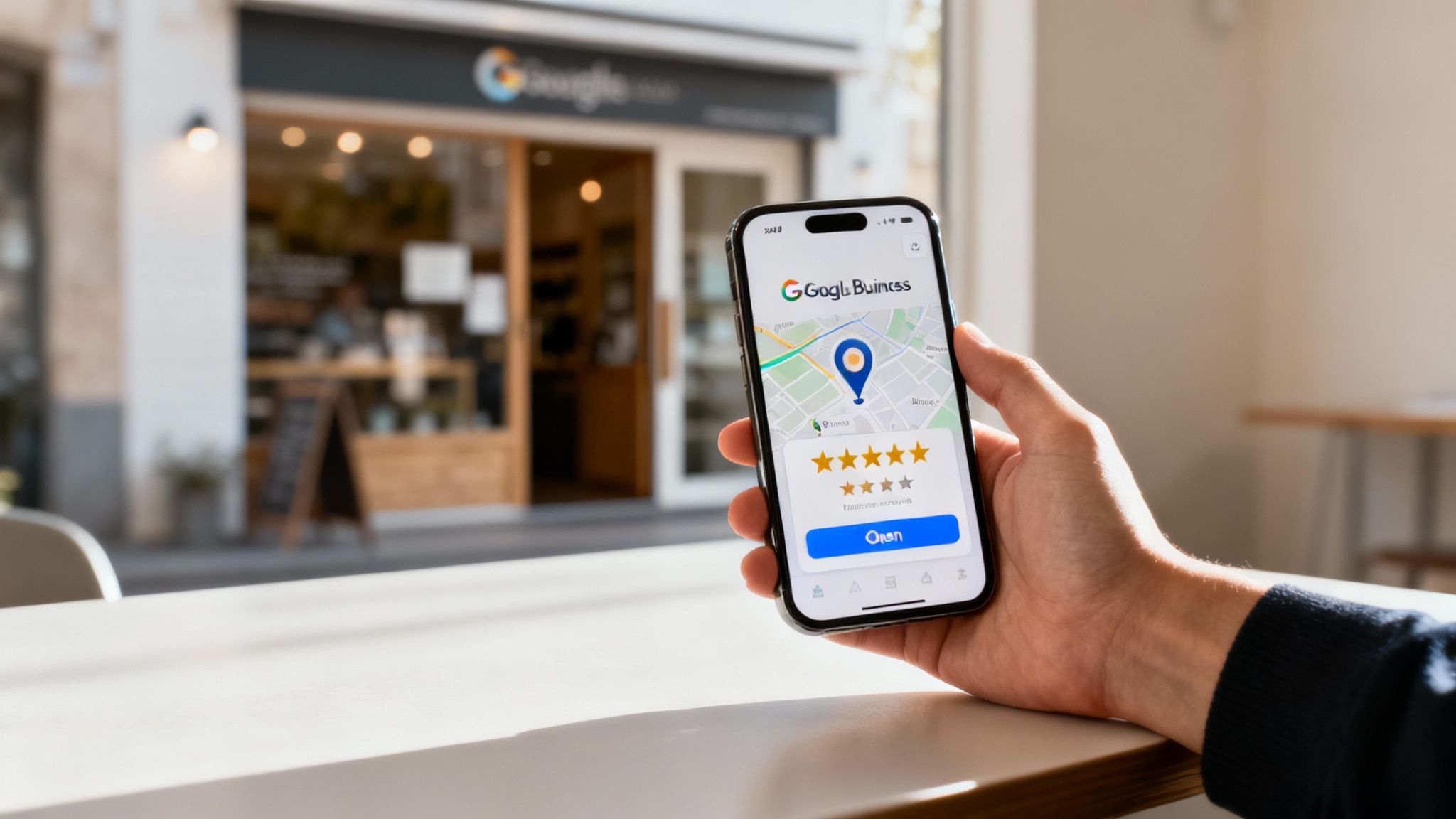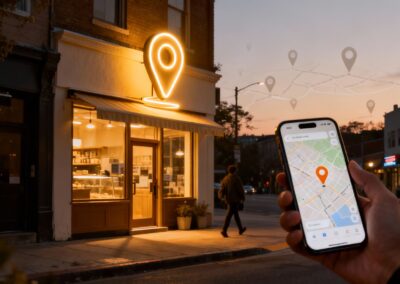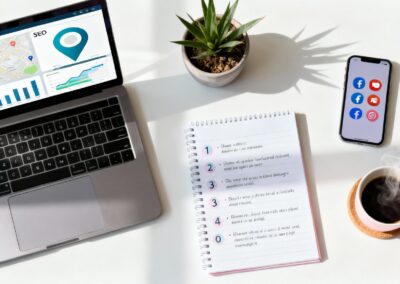If you're running a small business, you know the drill. You’re not just the CEO; you’re the head of sales, customer service, accounting, and, of course, marketing. Juggling all those roles is tough, but marketing often feels like the trickiest hat to wear.
The truth is, the core marketing challenges for small businesses almost always come down to the same five pressures: making a shoestring budget work, actually getting noticed online, standing out when you have a dozen local competitors, finding the time and know-how to do it all, and figuring out if any of your efforts are even paying off.
Confronting Small Business Marketing Realities
Forget the corporate jargon and complex theories. This guide is built for the real world you operate in every day. We're going to tackle those five fundamental challenges head-on with practical, no-fluff advice.
Think of this as your roadmap. For every hurdle we identify, we’ll lay out clear, actionable steps you can take. The goal is to move past the frustration and start turning these common problems into real growth opportunities.
The Five Core Hurdles for Owners
Marketing a small business isn't like playing in the big leagues. You don't have a massive team or a bottomless budget. Every dollar and every hour has to count. These hurdles are all connected, too. A tight budget makes it harder to gain visibility, which in turn makes it tougher to compete.
You can see how these pressures all link together.

This map gets right to the point, showing how budget, visibility, competition, time, and ROI are the central obstacles you're up against.
Building a Practical Framework for Success
It's easy to feel overwhelmed, but the secret is to be systematic. When you address each challenge with a specific strategy, you start building a marketing machine that works for you, even when you’re short on resources. You’ve come to the right place for real answers.
The goal is to transform marketing from a daunting, time-consuming chore into a manageable, effective system that frees you up to focus on running your business. This means prioritizing high-impact activities and using smart tools to handle the rest.
A marketing automation for small businesses guide can be a game-changer here, as it lays out how to put repetitive tasks on autopilot so you can focus on the big picture.
Throughout the rest of this guide, we'll break down exactly how to:
- Maximize your budget: We’ll focus on low-cost tactics that deliver a real, measurable return.
- Boost online visibility: Learn straightforward SEO and content strategies to get in front of local customers.
- Differentiate your brand: Use your small size to your advantage and build genuine customer loyalty.
- Manage your time: Discover systems and tools that simplify your marketing workflow without breaking the bank.
- Measure what matters: We’ll show you how to track the numbers that directly impact your revenue.
1. Making Every Dollar Count with a Limited Budget
For most small businesses, the marketing budget feels less like a war chest and more like a piggy bank you're shaking for loose change. It’s tough. You see competitors running splashy ad campaigns, and it's easy to feel like you’re bringing a slingshot to a cannon fight. This is one of the most common and frustrating realities for small business owners, but a small budget doesn't mean you can't make a big impact.
The trick is to stop thinking about what you can't do and start focusing on what you can control. A limited budget forces you to be smarter, more creative, and more focused than your bigger competitors. You can't afford to waste a single dollar on tactics that don't deliver, which is actually a hidden advantage. It pushes you toward high-return, low-cost strategies that build a real connection with customers.
Prioritize High-Impact, Low-Cost Tactics
First things first: forget trying to compete with national brands on expensive TV commercials or billboard ads. That's not your game. Your strength is your local presence and the direct connection you can build with your community. The goal is to find the marketing channels where a small, smart investment can punch way above its weight.
Here’s where to focus your limited funds for maximum effect:
- Local SEO (Search Engine Optimization): This is all about making sure local customers find you the moment they search for what you offer. Optimizing your Google Business Profile is completely free and is arguably the single most powerful marketing tool you have.
- Direct Email Outreach: Building an email list lets you speak directly to people who have already raised their hands and shown interest in your business. It's a cheap, effective way to promote specials, share news, and build loyalty without constantly paying for ad space.
- Hyper-Targeted Social Media Ads: Instead of casting a wide, expensive net, you can spend as little as $5 a day on platforms like Facebook or Instagram to reach a very specific audience in your immediate area. You can target people by zip code, interests, and even recent life events.
Find Free and Affordable Marketing Tools
You don't need an enterprise-level software budget to look professional and manage your marketing efficiently. So many powerful tools are available for free or at a very low cost, which really helps level the playing field.
For example, you can design fantastic graphics for social media, flyers, and emails using free tools like Canva. There are free starter plans for email marketing platforms and free social media schedulers to help you stay consistent without being glued to your phone. These resources turn your effort into tangible results without draining your bank account.
The bottom line is this: a small budget demands smart, focused decisions. You have to learn to identify your most profitable marketing channels and pour your resources there, avoiding the trap of spreading yourself too thin across too many platforms.
This approach isn't just about saving money; it’s about making every dollar work harder for you. And the data backs this up. A 2024 survey showed that 27% of small business professionals see budget constraints as their biggest hurdle, second only to lead generation at 30%. Even so, 56% are still aiming to increase sales, proving that smart marketing is the bridge to growth. You can read the full research about these small business trends for more context.
Adopt a "Test and Measure" Mindset
With a tight budget, you simply can't afford to guess what works. Adopting a simple "test, measure, repeat" philosophy is essential. Before you go all-in on any single channel, run a small test.
For instance, spend a small amount on two different Facebook ads, maybe one with a great photo and another with a short video. Track which one gets more clicks or generates more phone calls. Once you have a clear winner, you can confidently put more of your budget behind it. This data-driven approach ensures your limited funds are always invested in the strategies that are proven to deliver results for your business.
2. Breaking Through the Noise to Gain Online Visibility
If potential customers can't find you online, you might as well be invisible. It's one of the most maddening marketing challenges for any small business owner. You pour your time and energy into creating social media posts or tweaking your website, only to feel like you're shouting into a void while bigger competitors seem to be everywhere.
That feeling isn't just in your head. It's the reality of today's crowded digital world. Just "posting more" isn't a strategy; it's a fast track to burnout. To actually break through and get noticed, you have to be smarter and more focused, putting your effort where it will make the biggest difference.

Why Organic Reach Is on Life Support
One of the biggest hurdles is the slow decline of organic reach on social media. A few years ago, a post on your business's Facebook page could reliably find its way to a big chunk of your followers. Those days are long gone.
This isn't an accident. Social platforms have tweaked their algorithms to heavily favor paid content, turning what was once a community space into a pay-to-play arena. As of 2025, it's not unheard of for a small business's organic post to be seen by fewer than 20 people without a paid boost behind it. This is a direct result of platforms like Meta nudging businesses toward their advertising tools. You can discover more insights about small business marketing challenges and see how these trends are reshaping the game.
The takeaway here is that while social media still has its place, relying on it alone to be seen is a recipe for failure. You have to diversify your strategy so customers can find you right when they're looking for you.
To help you prioritize, here are some of the most effective strategies you can implement right away to start getting seen by more local customers.
High-Impact Strategies for Boosting Local Visibility
| Strategy | Why It Works | First Action Step |
|---|---|---|
| Optimize Google Business Profile | It's your digital storefront on Google and often the first thing local searchers see. A complete profile builds trust and improves your ranking in local map results. | Claim your profile, then fill out every single section with accurate info: hours, address, services, photos, and phone number. |
| Master Local SEO | This helps you appear in "near me" searches. It tells Google you're a relevant local answer for what the customer is looking for. | Ensure your business name, address, and phone number are consistent across your website and all major online directories. |
| Get More Customer Reviews | Reviews are a huge ranking signal for Google. They provide powerful social proof that tells new customers and search engines you're a trustworthy choice. | Create a simple system to ask happy customers for a review, like a follow-up email with a direct link or a QR code on your receipts. |
| Create Engaging Content | Certain formats, like short-form video and carousels, are favored by algorithms, giving you more organic reach than a standard post. | Film a quick 15-second "behind-the-scenes" video on your phone or create a multi-image post showcasing a finished project. |
Putting these pieces together creates a powerful foundation for your online presence, ensuring you're not just making noise, but actually getting found.
Your Most Powerful Free Marketing Tool
When it comes to local visibility, nothing beats your Google Business Profile (GBP). It's the free business listing that shows up in Google Maps and the "local pack" in search results. For someone in your town searching for "plumber near me" or "best coffee shop," a well-managed GBP is often the very first thing they see.
Think of it as your front-and-center billboard on the world's biggest search engine. Keeping it optimized isn't just a good idea; it's absolutely essential.
A complete and active Google Business Profile not only helps you show up in more local searches but also gives potential customers the confidence to choose you over a competitor with a sparse or outdated listing.
Ready to get your profile in shape? Here’s a quick checklist:
- Claim and Verify Your Listing: This is step one. It gives you control over your business's information on Google.
- Complete Every Section: Fill out your hours, address, phone number, website, and services with 100% accuracy. Don't leave anything blank.
- Upload High-Quality Photos: Show off your products, your storefront, your team, and your work. Profiles with photos get 42% more requests for driving directions on Google Maps.
- Use the Q&A Feature: Get ahead of customer questions by adding your own FAQs and answering them. It’s a great way to provide helpful info upfront.
Create Content That Algorithms and People Actually Love
While overall organic reach is down, some types of content still get a serious boost from social media platforms. Why? Because they're designed to be highly engaging. Short-form videos (like Instagram Reels or YouTube Shorts) and multi-image carousels are perfect examples.
These formats keep people on the platform longer, so the algorithms reward you by showing your content to a wider audience. You don't need a fancy production studio, either. A simple video of a finished project, a quick look at your process, or a carousel of happy customer photos can be incredibly effective.
Systematically Encourage Customer Reviews
Finally, nothing builds trust and boosts your visibility quite like a steady stream of glowing customer reviews. For Google, reviews are a major ranking factor in local search. For potential customers, they're the social proof that convinces them you're the real deal.
Don't just sit back and hope for reviews to come in. Create a simple, repeatable process to ask for them. This could be an automated follow-up email after a purchase, a small card with a QR code tucked into a shopping bag, or even just a friendly verbal request when you finish a job. The key is making it dead simple for your happy customers to share their feedback. Each new five-star review makes you a little more visible and a lot more trustworthy.
3. Standing Out in a Saturated Local Market
If your town is anything like most, it feels like a new competitor pops up on every corner. For a lot of small business owners, this is one of the most stressful parts of the job. You're not just up against the big-box stores; you’re often fighting for the exact same customers as another small business just a few blocks away.
So, how do you become the go-to choice when customers have so many similar options?
It’s a tough spot, no doubt. But your small size is secretly your greatest strength. Larger companies can’t easily create genuine, personal connections. You, on the other hand, can build a loyal following by telling a better story, delivering an unforgettable customer experience, and weaving yourself into the community in a way they simply can’t.

This feeling of being crowded out is a massive issue. In fact, in 2025, over half (52%) of small business owners said their main rivals were other small businesses, not the big chains. This saturation creates real indecision for shoppers, with 62% admitting they find it hard to choose between similar local businesses. You can learn more about these small business marketing statistics to see the full picture.
Define What Makes You Different
Before you can stand out, you have to know why you should stand out. This is your Unique Value Proposition (UVP): the one thing that makes you the clear choice. It’s not just about what you sell; it’s about how you sell it, who you are, and the value you provide that no one else can touch.
To figure out your UVP, ask yourself three simple questions:
- Who is my ideal customer? Get specific. What do they really care about? Is it speed, quality, price, or a friendly face?
- What problem do I solve for them better than anyone else? Maybe you offer the most durable product, the fastest service, or the most expert advice in town.
- What’s my personality? Are you the fun, quirky option? The reliable, traditional expert? The modern, eco-friendly choice?
Your answers become the heart of your marketing. Think about it: two local coffee shops might sell the same latte, but one can win by highlighting its ethically sourced, single-origin beans (for the connoisseur), while the other wins with lightning-fast mobile ordering (for the busy commuter). Same product, completely different value.
Turn Your Local Status into an Advantage
Being a local business isn't just a fact; it's a powerful marketing tool. People genuinely want to support their neighbors. Your job is to make it easy and rewarding for them to do so.
The key is to stop trying to out-spend your competitors and start trying to out-connect them. Build relationships and create a community around your brand that people feel proud to be a part of.
Here’s how to put your local identity to work:
- Showcase community involvement: Sponsor a local Little League team, host a charity drive, or partner with another nearby business for a sidewalk sale. Post about it on social media to show you’re truly invested in the town.
- Leverage customer testimonials: Feature glowing reviews from local customers on your website. A quote from "Jane D. from down the street" is far more powerful than a generic review from a stranger.
- Use personal touches: A handwritten thank-you note in a shopping bag, remembering a regular’s name, or a personalized email can create fierce loyalty. These small gestures are things that big, impersonal companies can't easily replicate.
Build Your Reputation with Local SEO
Finally, being the best-kept secret in town doesn’t pay the bills. You need to make sure local customers can find you online the moment they need you. This is where local search engine optimization (SEO) comes in.
By optimizing your online presence for searches like "best pizza near me," you put your business directly in front of motivated buyers. If you're looking to get started, our guide on how to improve local SEO is a great resource. When you combine a strong, unique identity with excellent local visibility, you create a winning formula that even the most crowded market can’t beat.
4. Overcoming the Time and Expertise Gap
If you’re a small business owner, you’re not just the CEO. You’re also the head of sales, the bookkeeper, the customer service rep, and yes, the entire marketing department. It’s an exhausting juggling act, and it’s one of the biggest marketing hurdles small businesses have to clear. There just isn’t enough time in the day to master everything, and marketing can feel like a full-time job all on its own.
But here’s the good news: you don’t need to be a marketing wizard to see real results. The key is to stop trying to do it all. Instead, focus on a handful of high-impact strategies that bring in most of your business. It's all about working smarter, not harder.

Embrace the 80/20 Rule of Marketing
For any time-crunched entrepreneur, the 80/20 rule (also known as the Pareto Principle) is a lifesaver. It’s a simple idea: roughly 80% of your results will come from just 20% of your efforts. Your job is to figure out what that powerful 20% is and pour your limited time and energy into it.
Don't try to be everywhere at once. Instead of posting on five different social media platforms, find the one or two where your ideal customers actually spend their time and get really good at it. Instead of trying to write long, complicated blog posts, maybe a simple, high-value email newsletter that goes out twice a month is a better fit. This kind of ruthless prioritization is your best weapon against burnout.
To put this into practice, take an honest look at where your best customers are coming from right now.
- Do most of your new leads find you through a Google search? Then your 20% is probably local SEO.
- Do repeat customers make up the bulk of your revenue? Then your 20% is nurturing your email list.
- Are you getting a ton of referrals from a local Facebook group? That's your 20%.
Once you know what’s working, you can confidently let go of the rest and double down on the activities already proven to move the needle for your business.
Create Simple, Repeatable Systems
When it comes to small business marketing, consistency beats complexity every single time. Stop reinventing the wheel every week and start creating simple systems that you can execute almost on autopilot. This approach turns marketing from a daunting creative challenge into a manageable checklist.
The goal is to build a marketing engine that runs on simple, repeatable actions. This consistency builds momentum and frees up your mental energy to focus on running your business, not just marketing it.
Start by creating a few key templates. A basic one-page content calendar, for example, can help you map out an entire month of social media posts in a single afternoon. You also need a crystal-clear picture of who you're talking to; our guide on how to create buyer personas can walk you through building simple profiles of your ideal customers so your messaging always connects.
Use User-Friendly Tools to Get Time Back
You don’t need a degree in marketing technology to simplify your workflow. There are tons of amazing, user-friendly tools out there designed specifically for small businesses. They can handle the repetitive stuff for you, no steep learning curve required.
Here are a few types of tools that can save you hours every single week:
- Social Media Schedulers: Platforms like Buffer or Later let you schedule a whole week's worth of posts in one go.
- Email Marketing Platforms: Services like Mailchimp or Flodesk offer simple drag-and-drop editors to create professional-looking emails in minutes.
- Graphic Design Tools: Canva has thousands of templates that let you create beautiful visuals for social media, flyers, or your website, even with zero design experience.
When you combine the 80/20 rule with simple systems and the right tools, marketing transforms from a chore you dread into an efficient, powerful system that grows your business without taking over your life.
5. Measuring Marketing Success Without the Headache
"Is any of this actually working?"
It’s one of the most common and stressful questions small business owners ask themselves. You pour precious time, effort, and money into your marketing, but figuring out if it’s making a real difference can feel like a total shot in the dark. It's way too easy to get lost in a sea of data and confusing analytics dashboards.
But it doesn't have to be that way.
The secret is to tune out the noise, like social media likes or random website page views, and laser-focus on the numbers that directly affect your bank account. You don't need a data science degree for this. You just need a clear line of sight connecting your marketing activities to tangible results like sales, leads, and new customers. This is how you prove your marketing is paying for itself and start making smarter bets with your budget.
For many small businesses, the challenge is simply knowing where to start. Focusing on solid Performance Analytics can cut through the clutter and make the whole process manageable.
Track What Truly Matters
Instead of trying to keep an eye on dozens of different data points, just start with a few Key Performance Indicators (KPIs) that are a direct reflection of business growth. For a local business, these are the actions that actually put money in your pocket.
Here are a few simple, high-impact KPIs to get you going:
- Contact Form Submissions: How many potential customers are actually raising their hand and asking for more information on your website?
- Phone Calls from Google Business Profile: This is gold. It measures how many people found you on Google and were motivated enough to pick up the phone right then and there.
- Coupon Redemptions: If you run a special offer in an email or a local ad, how many people showed up to use it?
- New Email Subscribers: This tracks the growth of one of your most valuable assets, your direct line of communication with people who want to hear from you.
These aren't just abstract numbers. They represent real people taking a real step toward becoming a paying customer. When you focus on them, you can finally draw a clear line from a marketing campaign to a concrete result.
Create a Simple Marketing Dashboard
Forget about expensive, complicated software. A basic spreadsheet is all you need to build a powerful marketing dashboard that keeps you zeroed in on what's important. This isn’t about creating elaborate charts; it’s about getting the numbers you care about in one place so you can spot trends over time.
A straightforward dashboard gives you a snapshot of your marketing's health at a glance. It turns abstract data into a clear story, showing you what’s working, what’s not, and where to put your energy next.
Here’s a simple template you can build out in Google Sheets or Excel:
| Metric | Goal for the Month | Week 1 | Week 2 | Week 3 | Week 4 | Monthly Total |
|---|---|---|---|---|---|---|
| Form Submissions | 20 | 4 | 6 | 5 | 7 | 22 |
| Phone Calls (GBP) | 30 | 8 | 5 | 9 | 10 | 32 |
| Email Signups | 50 | 10 | 15 | 12 | 11 | 48 |
| Coupon Redemptions | 15 | 2 | 5 | 3 | 6 | 16 |
Just take a few minutes to update this once a week. This simple habit keeps you plugged into your results and helps you spot patterns. Did phone calls suddenly jump after you added new photos to your Google Business Profile? Did form submissions go up right after you launched that new ad?
This is how you start making decisions based on facts, not feelings. It’s how you justify your marketing spend and finally answer that critical question, "Is it working?", with a confident, "You bet it is."
Answering Your Top Marketing Questions
When you're trying to figure out marketing for your small business, it's easy to get stuck on a few key questions. It turns out, most entrepreneurs have the same ones. Let’s get you some clear, straightforward answers.
How Much Should a Small Business Spend on Marketing?
This is a classic question, but we can get pretty close to a solid answer. A good rule of thumb for an established business is to set aside 5-10% of your revenue for marketing. If you're a startup just getting off the ground or pushing hard for growth, that number might look more like 12-20% to build that crucial early momentum.
But here’s a better way to think about it: instead of pulling a percentage out of thin air, work backward from your goals. Figure out what you actually want to accomplish, maybe it's getting 20 new qualified leads every month. From there, you can calculate what it will cost to hit that target using the strategies we've talked about. This turns marketing from an expense into a predictable investment.
What Is the Single Most Important Activity for a Local Business?
If you have time to do only one thing, this is it: fully claim and optimize your Google Business Profile (GBP). Seriously. It is, by a long shot, the most powerful free marketing tool you have.
Think of your GBP listing as your company's front door on the internet. It’s the first thing people see when they search for you or what you offer nearby. It's how they find your address, check your hours, see your photos, and read reviews before deciding to give you a call or stop by. A complete, active profile is the bedrock of local visibility.
All your other marketing, like social media posts, ads, or flyers, is about getting people's attention. Your Google Business Profile is what catches that attention the moment a potential customer is actively looking for a solution you provide.
How Long Does It Take to See Marketing Results?
The honest answer? It depends entirely on what you’re doing. Some tactics give you a quick jolt of activity, while others are a slow burn that pays off big time down the road. That’s why using a mix of strategies is almost always the smartest move.
Here's a rough timeline of what to expect:
- Quick Wins (A Few Weeks): A well-tuned paid ad campaign on Google or Facebook can start sending traffic and leads your way almost instantly. You can literally have the phone ringing in a matter of days.
- Medium-Term (1-3 Months): This is where things like consistent social media posting and actively encouraging customer reviews start to pay off. You’ll build credibility and a stronger community connection that starts to generate its own momentum.
- Long-Term (6+ Months): SEO is a marathon, not a sprint. Building your authority with search engines takes time, and you likely won't see major jumps in your rankings for at least six months. But the payoff is huge: sustainable, "free" traffic from customers who are looking for exactly what you do.
At Digital Lotus Marketing, we specialize in creating custom strategies to solve these marketing challenges and drive real growth for your business. Contact us today for a consultation.





